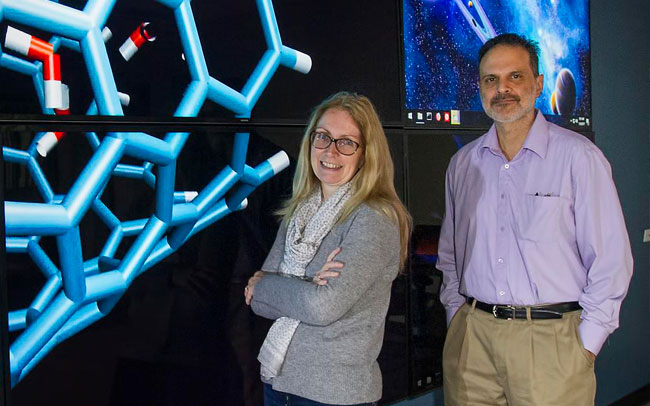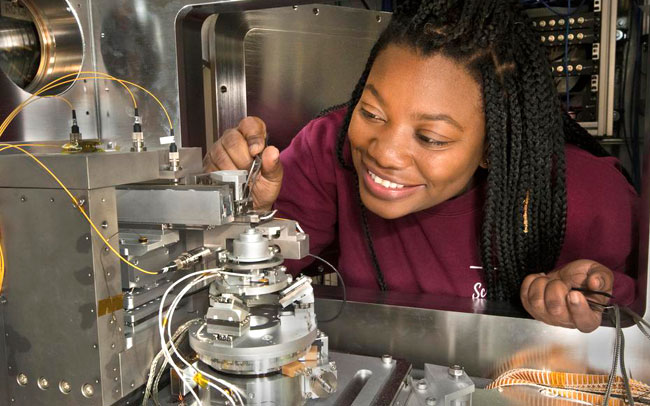
Brookhaven’s research themes stem directly from the Lab’s traditional strengths and core capabilities. The combination of world-leading research facilities, expert scientists and support staff, and cutting-edge equipment plays a unique role in addressing national needs, such as advancing our fundamental understanding of the universe, developing the breakthrough technology of tomorrow, and educating the next generation of scientists. These capabilities enable Brookhaven to deliver transformational science and technology aligned with the mission of the U.S. Department of Energy.
Many of the world’s most powerful and productive accelerator facilities incorporate technologies first designed and tested at Brookhaven, where the next generation of discovery instruments continue to be developed. The Lab’s Accelerator Test Facility (ATF) supports a broad range of user-driven research into beam physics, novel radiation sources, and advanced accelerator technology and provides hands-on training for the next generation of accelerator physicists.
Driven by the massive data collection and storage requirements of our experiments, Brookhaven has become one of the largest data science labs in the DOE complex. We operate the third-largest scientific data archive worldwide, with over 500 petabytes analyzed annually. Our Computational Science Initiative (CSI) also organizes extensive data programs in national security, machine learning, and visual analytics.
As an extension of our expertise in condensed matter physics and materials science, we have a concentrated effort aimed at developing new materials for renewable energy technologies. For example, the capabilities of NSLS-II enable the study of batteries and other energy storage materials in real time and under real-world operating conditions. This work is a key part of our collaboration with New York State on its efforts in modernizing the electric grid. We also conduct research to enhance the properties of these complex materials, particularly for the storage and transmission of electrical energy.
Brookhaven’s expertise in mathematics underpins the Lab’s long history of achievements in experimental physics. Today, applied mathematics is an essential component to all areas of Brookhaven Lab’s science. In particular, the Lab applies its mathematics research to modernize, optimize, and streamline experimental research. Led by the Computational Science Initiative, this effort integrates multiscale modeling, systems optimization, and scalable artificial intelligence solutions.
Brookhaven Lab is home to several research facilities, including the National Synchrotron Light Source II and the Center for Functional Nanomaterials, where scientists can study chemical reactions in real time and visualize molecular structures at ultrasmall scales. Researchers at Brookhaven use these tools to study chemical conversion reactions for sustainable energy applications, such as artificial photosynthesis and carbon capture. The Lab is also expanding its capabilities for studying chemistry in extreme environments. .
Brookhaven has a small but high-impact effort in applied chemistry research that generates deployable technologies. For example, the Lab has developed electrocatalysts that enhance the efficiency and efficacy of fuel cells, such as those for electric vehicles.
Our researchers study complex biological systems—from the molecular scale to the organism level—with an emphasis on using plants to advance energy and environmental sustainability. Brookhaven’s expertise includes measuring and modeling metabolic changes in single cells and tissues, as well as studying genetic mechanisms in plants, to enable the development of superior biofuel crops. Brookhaven scientists at NSLS-II and our cryo-electron microscopy facility are also investigate the structures and functions of proteins to enhance drug discovery and the treatment of disease.
Brookhaven seeks to better understand the combined effects of aerosols, clouds and other atmospheric phenomena on energy security and societal well-being. BNL’s field research includes partnering with the U.S. Department of Energy’s Atmospheric Radiation Measurement user facility; designing and conducting measurement campaigns that explore the intricacies of the atmosphere; study the formation, growth, and optical properties of clouds and aerosols; provide data to improve numerical prediction tools; and probe the combined impacts of these environmental factors on energy production, infrastructure, and demand. Brookhaven scientists use high performance computing systems and artificial intelligence techniques to probe these complex and critical challenges.
The Computational Science Initiative (CSI) at Brookhaven Lab harnesses expertise in computer science, applied mathematics, and domain sciences to develop highly impactful, high-performance numerical simulation codes in nuclear physics, materials science, chemistry, biology, and particle accelerator physics. CSI’s partnerships with industry and other national labs have influenced the development of advanced coding and software for exascale computing. CSI also develops and uses advanced modeling capabilities essential to theoretical analyses across a broad range of fields.
Brookhaven conducts fundamental research on new and improved materials for applications in renewable energy, energy storage, quantum information science, and energy efficiency. These include high-temperature superconductors for carrying electric current with perfect efficiency and new materials for solar cells and electronics. The Lab’s research combines scientific, university, and industry expertise with Brookhaven’s unique suite of complementary facilities for synthesizing new materials and studying their properties. These programs link basic science with industrial applications, bridging the gap between discovery and deployment of game-changing technology.
Since the Lab’s founding, Brookhaven has constructed and operated large-scale research facilities that individual institutions could not afford, and would not have the range of expertise required, to develop on their own. Called “user facilities,” these resources serve scientists—thousands every year—who study a wide range of fields. The renowned capabilities these facilities provide are often made possible by the Lab’s Instrumentation Division, which is a world leader in developing detectors, electronics, and metrology systems. Learn more about the Lab’s user facilities.
Brookhaven’s expertise in nuclear and radio chemistry has widespread applications that range from medicine to national security. The Lab plays a critical role in producing radioisotopes that are otherwise unavailable to the nuclear medicine community and industry. These isotopes are used around the world for disease diagnosis and treatment, and the Lab is even working to produce new isotopes for clinical trials on targeted cancer treatments. Brookhaven also has extensive expertise in nuclear safeguards, security and energy policy, and radiation detector development.
Brookhaven conducts pioneering explorations of the most fundamental aspects of matter. At the Relativistic Heavy Ion Collider (RHIC), scientists smash atoms together to liberate their inner building blocks (quarks and gluons) and recreate the conditions of the early universe, mere microseconds after the dawn of time. RHIC results have led to unexpected discoveries about the nature of the infant universe and to profound intellectual connections between other physics frontiers, including String Theory and condensed matter systems. Brookhaven will also soon be home to the Electron-Ion Collider, a next-generation nuclear physics facility that will greatly expand scientists’ ability to explore the building blocks of visible matter. .
Scientists at Brookhaven Lab are hunting for the fundamental source of mass, the nature of dark matter and dark energy, and the origin of the matter-antimatter asymmetry in the universe. The Lab provides intellectual and technical leadership in key particle physics experiments that investigate the composition and evolution of the universe, from the smallest building blocks of matter to the mysteries of deep space. For example, Brookhaven serves as the U.S. host institution for the ATLAS detector at the Large Hadron Collider (LHC).
Brookhaven Lab’s cutting-edge experiments often require custom-built machinery and electronics. Many individual facility components—including accelerators, detectors, and beamlines—that are conceived, designed, and implemented at Brookhaven are complex entities, requiring broad expertise for their successful performance and integration with other systems. Brookhaven’s skill at managing these large-scale projects extends not only to engineering at the various stages of an experiment, but also to developing new technologies that fuel multiple large collaborations throughout the Lab.
Researchers at Brookhaven Lab are developing new tools and characterization techniques for studying nuclear energy system materials, such as robots for handling radioactive samples, x-ray experiments to investigate how materials degrade, and an energy frontier research center for studying molten salts in extreme environments. Beyond the Lab’s research on nuclear materials, Brookhaven has experience with all phases of the design and assessment of advanced nuclear systems and hosts the National Nuclear Data Center.
Complementary to the Lab’s research on new materials for renewable energy applications, Brookhaven works to develop renewable energy systems and integrate them into the electric grid. Brookhaven applies its expertise in power system modeling and simulation, as well as transmission and distribution systems, to analyze renewable energy technologies, determine their appropriate use, and deploy them. This effort is part of the Lab’s goal to enable the next generation smart grid.





















